Editor’s note: This article was updated 11 May, 2023 to update information and re-organize information within the article.
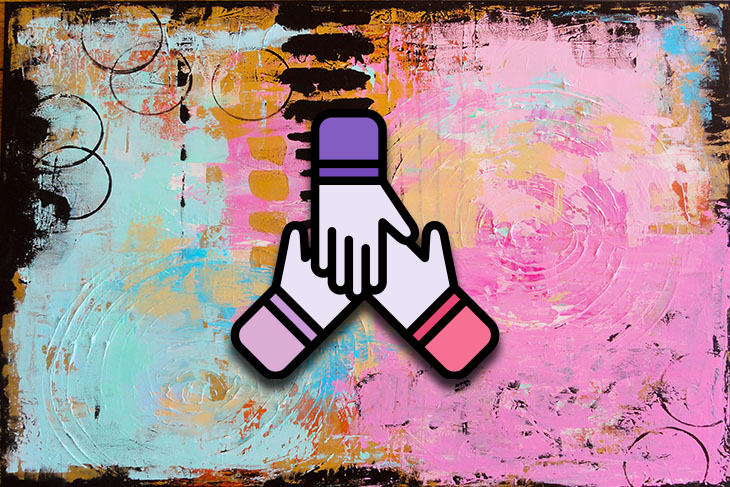
It feels like almost everyone either already works in scrum or aspires to work in scrum. It’s not surprising: the framework may already be 30 years old, but it’s still one of the most effective approaches to solving complex problems we have.
The central part of scrum is the scrum team and its corresponding scrum roles: product owner, scrum master, and developer. Without properly implemented scrum roles, the whole framework would fall apart.
Let’s dig deeper to understand the specific roles, their responsibilities, and how they work with the other roles and stakeholders involved in the scrum process.
Let’s start with a primer on scrum itself. In plain English, scrum is a framework that helps teams deliver value.
According to The Scrum Guide, scrum is “a lightweight framework that helps people, teams, and organizations generate value through adaptive solutions for complex problems.”
Essentially, scrum provides a basic structure and nothing more. It doesn’t tell us exactly how to solve problems, nor does it offer a step-by-step process. Rather, it has core principles that enable teams and organizations to use and customize to their own organization. It works by scrum teams committing to delivering and executing a set of product features within a brief period called a sprint. Sprints, or iterations, adapt to any necessary changes in the features delivered, based on market demand.
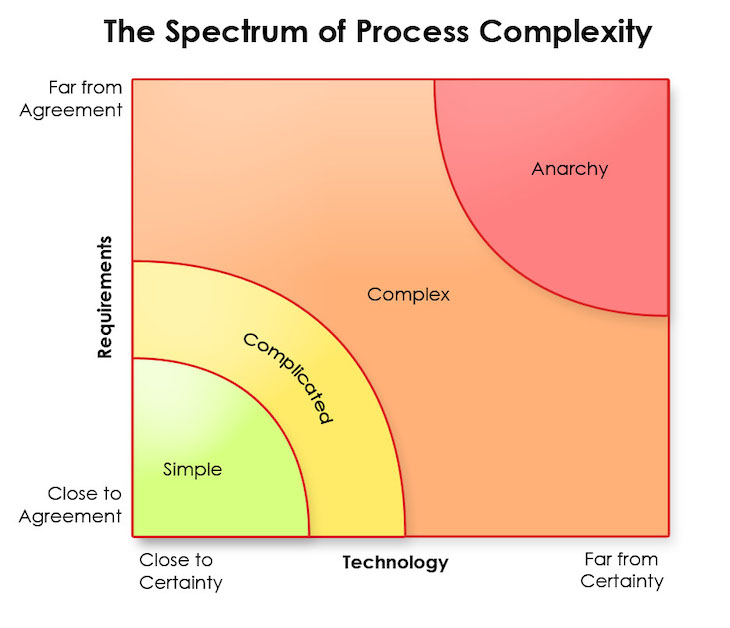
Scrum consists of five building blocks:
In this guide, we’ll dig deeper into the third building block: the scrum team.
The scrum team is the fundamental unit of scrum. In short, it’s a small group of professionals working together toward the product goal — scrum cannot function without the team. To achieve its purpose, the team must be small, cross-functional, and self-managing. Let’s explore these three qualities in more detail.
While it’s no longer a hard rule, the recommended team size is 10 people or fewer. The scrum team should be small enough to collaborate effectively. With bigger groups, it’s harder to align everyone and the communication overhead can dramatically reduce the team’s ability to deliver value.
If the problem is too big to be solved by a small team, consider creating multiple smaller groups working toward the same goal rather than building one big team. A supplementary framework, such as LeSS or Nexus, might help us achieve that.
The scrum team must be able to achieve the sprint goal with minimal external dependencies.
Ideally, the team should have all skills necessary to deliver the end product. It includes design, development, testing, integration, and any additional polishments. While using external help occasionally is okay, it shouldn’t be a standard procedure.
The team is not managed by any external authority; it should be self-organizing. The scrum team is best suited to decide how to achieve the product goal and should have the full authority to plan its work and priorities.
Collaboration and adaptability are key, and the roles within the scrum team are designed to support these principles. The three distinct scrum roles in the framework are:
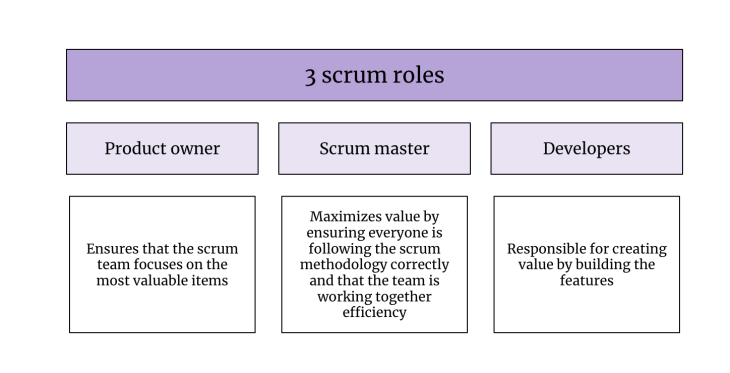
Let’s dig deeper to see how each of the three scrum roles contributes to the agile product development process.
Also referred to as a value maximizer, a product owner is responsible for ensuring that the scrum team focuses on the most valuable items. This person is accountable for outcomes, not outputs. After all, there’s no bigger waste than working on the wrong thing.
The product owner achieves that by maintaining and communicating a clear vision for the product and owning a product backlog.
The product vision is what enables the team to self-manage efficiently. Without a clear direction, the team wouldn’t have any meaningful boundaries, and self-organization would descend into anarchy.
The product backlog is an ordered list of items that tells the team what to work on next. A properly groomed backlog is like a roadmap to the product goal.
How a product owner achieves these outcomes varies from organization to organization. For example, a product owner at a smaller company might be responsible for user research, market validation, and business planning on their own. In bigger corporations, they often serve as facilitators and work closely with business stakeholders to elicit and clarify product requirements and vision.
Regardless of the setting, one thing remains constant: a product owner is the sole person accountable for the product backlog and, thus, the product direction. They might be influenced by external stakeholders and will likely delegate some responsibilities to other scrum team members, but the product owner has the final say.
Let’s take a closer look at some of the most important responsibilities of the product owner. Their primary responsibilities that follow the expectations of the scrum framework are to:
The above points tell us how the product owner keeps the scrum framework alive throughout the process. However, the product owner also has secondary responsibilities that span beyond scrum and speak more to their abilities as a product person. On top of the above responsibilities that are essential to the role, a great product owner is also involved in:
While a product owner maximizes value by ensuring the scrum team focuses on the most valuable items, a scrum master does so by ensuring the team’s effectiveness.
Scrum masters are so-called servant leaders; they radiate leadership by serving the product owner, the developers, and the organization. Their main role is to ensure that the scrum framework is being implemented properly.
The scrum master’s primary responsibility is to coach everyone involved in product development on scrums adoption. In the end, scrum is one of those things that is easy to understand yet difficult to master. While most people can easily understand the basics of scrum, the scrum master ensures the team truly masters the framework.
It’s not only about having particular events and artifacts in place. The scrum master ensures that the team adopts empiricism by focusing on transparency, inspection, and adaptation. They also help people truly understand and live scrum values.
Scrum masters are hands-on. They lead many of the scrum ceremonies, such as daily scrum meetings, backlog refinement sessions, and sprint retrospectives.
A successful scrum master’s responsibilities are to:
The name of this scrum role might be misleading. Many associate “developer” with a strictly technical programmer job — for example, Node.js developer. In scrum, a developer is any role that helps to develop the increment. Simply writing code is rarely enough to deliver a fully working product.
The developer role in scrum includes UX researchers, UI designers, QA experts, DevOps engineers, copywriters, etc.
For example, let’s say we’re building an informational product for the fintech industry. If our legal and finance specialists contribute product content to every iteration, they are also developers.
Developers are responsible for delivering a valuable increment each sprint. Let’s take a more detailed look at what scrum developers are accountable for:
Scrum roles tend to bring about a lot of confusion. Questions like, “What’s the difference between product owner and product manager?” and, “Is there a place for a project manager in scrum?” come up every day.
To the first point, the product manager and product owner roles are mutually important, yet distinctly different. The product manager focuses on building the right product. The product owner focuses on building the product right.
It’s also important to understand that scrum roles are not the same thing as job titles.
Your job title labels you as a specialist and can vary widely depending on the organization. Scrum roles describe how you contribute to the scrum team.
In other words, a scrum role is more of a hat you wear than an official job title.
For example, let’s say you’re a project manager with two teams assigned to you. Team A uses Kanban while team B uses scrum. In an organizational context, you are still a project manager, but with team A, you wear the hat of a service delivery manager. Meanwhile, with team B, you wear a scrum master hat. Each hat comes with a completely different set of responsibilities to its respective teams.
You also don’t have to be a product manager to be a product owner, just as you don’t have to be a programmer to be a developer. If you’re building a marketing product and the head of marketing is the most suitable person to prioritize the backlog and establish the product vision, then they are most suited to wear the product owner hat.
In short, your job title answers the question, “Who are you in this company?” while your scrum role answers the question, “What is your responsibility to the scrum team?”
Scrum is a lightweight framework that maximizes value creation in complex environments. The five elements of scrum are theory, values, team, events, and artifacts.
The scrum team is a critical part of the framework. It’s a small, cross-functional, small-managed group of people.
There are three distinct scrum roles:
| Role | Responsibilities |
|---|---|
| Product owner |
|
| Scrum master |
|
| Development team |
|
It’s critical to remember that scrum roles describe an individual’s relationship and responsibility to the scrum team; this is separate from job titles and career tracks.
Featured image source: IconScout
LogRocket identifies friction points in the user experience so you can make informed decisions about product and design changes that must happen to hit your goals.
With LogRocket, you can understand the scope of the issues affecting your product and prioritize the changes that need to be made. LogRocket simplifies workflows by allowing Engineering, Product, UX, and Design teams to work from the same data as you, eliminating any confusion about what needs to be done.
Get your teams on the same page — try LogRocket today.
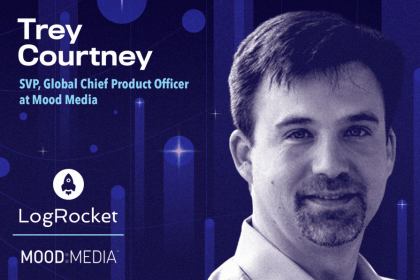
Trey Courtney talks about his process for evaluating partnerships or acquisitions and how he successfully implements these initiatives.
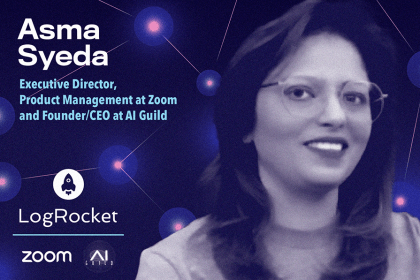
Asma Syeda shares the importance of responsible AI and best practices for companies to ensure their AI technology remains ethical.
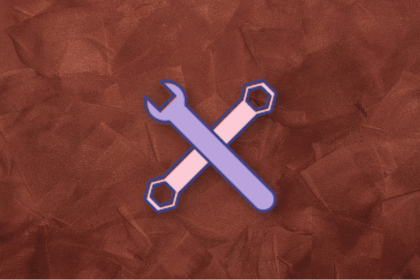
What hard skills do PMs need in 2025? Learn how AI tools can help you level up in SQL, Figma, A/B testing, and more.
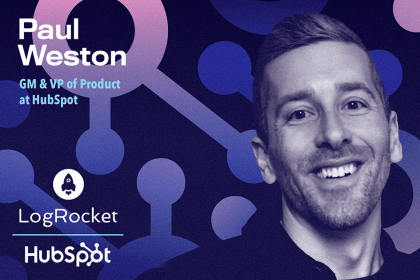
Paul Weston talks about “quantifying the unquantifiable,” i.e., bringing in objective data for things that otherwise seem hard to measure.